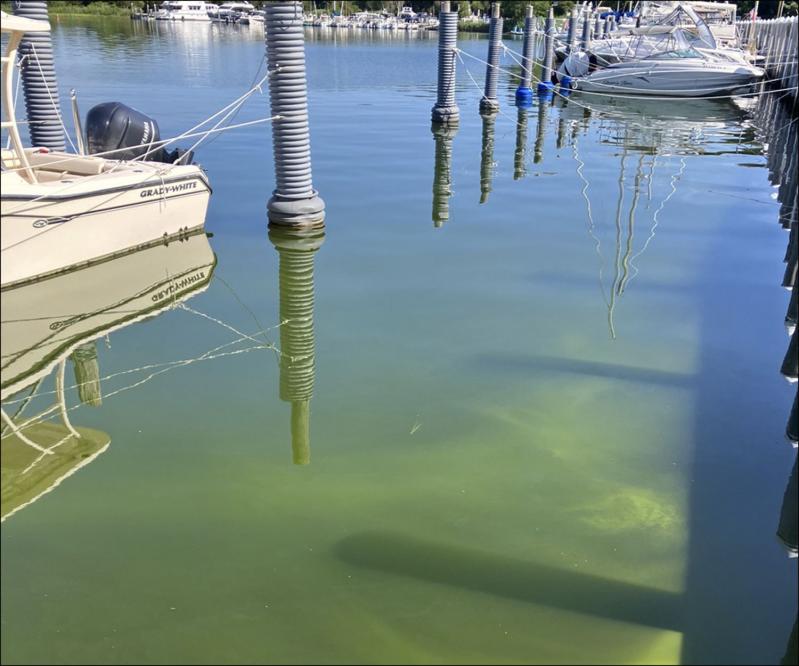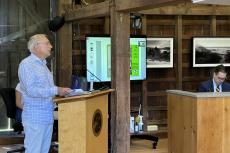As temperatures rise in East Hampton Town’s waterways, algal blooms are appearing, growing, and, in at least one case, declining.
John Aldred of the town trustees told his colleagues on Monday that Mark Mendelman of Three Mile Harbor Marina had contacted him last week to report a bloom at the head of the harbor. Mr. Aldred visited the site last Thursday “and sure enough, there was a bloom.” He took a sample the following day and carried it to the Gobler Lab at Stony Brook University for evaluation.
The sample had a chlorophyll concentration of 13.5 micrograms per liter and approximately 580 cells per milliliter of euglenoids, a group of single-celled organisms primarily found in freshwater habitats that exhibit a mix of plant-like and animal-like characteristics. The Gobler Lab described the concentration sampled as a modest amount, Mr. Aldred said. “It looked like a pretty dense bloom to me,” he said of the bloom in the harbor, “but it didn’t look very dense in the bottle.”
“They can get very dense and discolor the water, which I suspect happened the other day,” Christopher Gobler wrote to Mr. Aldred. Euglenoids are considered a harmful algal bloom, he said, because they produce toxins, specifically euglenophycin. “This is not a threat to public health but has been known to cause fish kills,” he wrote.
“When I was looking at the bloom, I noticed there were a lot of fish schooling around and apparently [exhibiting] normal behavior,” Mr. Aldred said. “I don’t think it was dense enough to do any damage that way.”
Another sample was taken on Monday, “and if anything interesting pops up, they will let us know,” he said.
Mr. Aldred then told his colleagues that the bloom of toxic cyanobacteria, or blue-green algae, in Wainscott Pond is actually declining. “I don’t know why.” The pond is annually besieged by cyanobacteria blooms in the summer months, and is typically the most compromised water body under trustee jurisdiction. Any measurement above 25 micrograms per liter is “reportable,” he said.
A graph displayed at the meeting showed the most recent sample at 168.85 micrograms per liter, a decline from the 303 micrograms per liter measured earlier this month and the 350 micrograms per liter measured in June. “This time last year, they spiked up into the 500 to 600 range, I think it was,” Mr. Aldred said, and reached almost 800 micrograms per liter in August. “It’s still a bloom, still toxic, but it’s not the numbers that it’s been in the past.”
While the levels of cyanobacteria have declined, “they are still very high,” Dr. Gobler wrote in an email to The Star. “The prior levels were so high, the bloom essentially starved itself by creating an unsustainably high level of biomass. Still, the levels now are higher than levels achieved just a few years ago.”
Cyanobacteria produce dangerous toxins called microcystins, and swimming in or ingesting such impaired water can be harmful or fatal to humans and pets. The State Department of Environmental Conservation considers the pond impaired and has placed it on its “priority waterbodies” list.
Wainscott Pond is adjacent to the 30-acre property purchased by the town last year for $56 million from the community preservation fund for the preservation of open space, agricultural lands, historic places and property, and the protection and improvement of water quality.
“It’s probably going to need some dredging and other stuff to clean it up,” said Bill Taylor of the trustees. “When you look at its history, it’s been used for agricultural purposes and stuff.” As it was recently purchased by the town, “it will be accessible for the first time soon, right?” he asked.
“It’s accessible now, but it’s not easy to get to,” Mr. Aldred said. “I went there this week and put up a sign to warn people about the algal blooms, and it was not easy to get to,” he said, describing thick vegetation around the pond.
In other news from the meeting, the trustees voted to appoint Richard Whalen as temporary trustee attorney. He will fill that role in place of Christopher Carillo, who, Francis Bock, the trustees’ clerk, said, recently underwent emergency surgery. He is recovering well, Mr. Bock said, but will be on extended recovery leave. Mr. Whalen, who has previously served as the trustees’ attorney, will be paid $925 per week.




